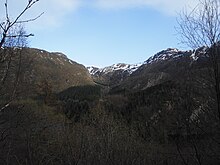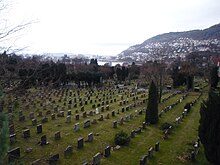Isdal Woman
Isdal woman | |
|---|---|
 Sketch by forensic artist Stephen Missal | |
| Born | c. 1940s |
| Status | Unidentified for 53 years, 8 months and 30 days |
| Cause of death | Combination of carbon monoxide poisoning and barbiturate overdose[1] |
| Body discovered | 29 November 1970 Isdalen Valley, Bergen, Norway |
| Resting place | Møllendal cemetery, Bergen |
| Known for | Mysterious death |
| Height | 164 cm (5 ft 5 in) |
The Isdal Woman (Norwegian: Isdalskvinnen) was found dead at Isdalen Valley in Bergen, Norway, on 29 November 1970. Long considered one of Norway's most profound mysteries, the case has been the subject of intense speculation for many years.[2]
Discovery
On the afternoon of 29 November 1970, a man and his two daughters were hiking in the foothills of Mount Ulriken's north face, in an area known as the Isdalen Valley. They found a partially-charred female, hidden among some rocks, in an area popularly known as "Death Valley." Also found were a dozen pink phenobarbital sleeping pills (brand name Fenemal); a packed lunch; an empty quart bottle of St. Hallvards liqueur; two plastic bottles that smelled of gasoline; and a silver spoon with the monogram filed off.[3] Investigators also found a burned passport.[4]

Investigation
An autopsy concluded the woman died from Fenemal and carbon-monoxide poisoning.[5] Her blood showed traces of at least 50 sleeping pills.[4] Her neck was bruised, possibly by a blow, and her fingerprints had been sanded away. Her teeth indicated she'd been to a dentist in the Far East, Central/Southern Europe or South America.[6][7]
Police immediately launched a full-scale investigation. They made composite sketches on the basis of witness descriptions and analysis of her body; these sketches were published in the media and circulated in many countries via INTERPOL.
They found two suitcases belonging to the woman at an NSB train station in Bergen. In the lining on one, police discovered 500 Deutsche Mark. Among other things, they found clothing (all identifying labels removed); a lotion prescription (doctor's name and date removed); 130 Norwegian kroner; silver spoons similar to what was found at the Isdalen Valley site;[3] partial fingerprints on a pair of sunglasses;[8] and some cryptic diary entries. Police later concluded the entries were coded dates and places the woman had visited.[9] An unusual dress was found as well; from that, police determined the woman had a somewhat provocative style, marked by Italian taste.
An Italian photographer's postcard was found in the woman's luggage. When police spoke with him, he said he'd given her a lift to and had dinner with her at Hotel Alexandra in Loen. According to the photographer, the woman told him she was from a small town north of Johannesburg in South Africa, and she had six months to see Norway's most beautiful places. This line of inquiry went nowhere.
Police learned "Isdal Woman" had traveled around Norway and Europe with at least eight false passports. Authorities eventually concluded the woman committed suicide. In 2016, a DNA profile was obtained from the woman's teeth.[5]
Witness descriptions and itinerary

Witnesses said the woman wore wigs and spoke French, German, English, and Dutch. She'd stay at several Bergen hotels and repeatedly changed rooms after checking in.[10] She told staff at the hotels she was a traveling saleswoman and an antiquities collector; she left a standing order at several places for porridge with milk.
One witness said she overheard the woman talking to a man in a Bergen hotel. According to the witness, the woman said, "Ich komme bald" (German: "I am coming soon").
The last hotel "Isdal Woman" stayed at was the Hotel Hordaheimen (room 407, November 19–23). Staff told police she was good-looking, 5-feet-4-inches (164 cm) tall, with wide hips and small eyes. She appeared to be between 30 and 40 years old. Another Hordaheimen guest told police the "Isdal Woman" smoked South State cigarettes (a Norwegian brand). Staff noted the woman kept mainly to her room and seemed to be on guard. When "Isdal Woman" checked out of the Hordaheimen on November 23, she paid her bill in cash and requested a taxi. Where she was between this date and November 29 (when her body was found) is unknown.
According to a brief and vague article in a local Bergen tabloid, a local man said he went to police after recognizing the composite sketch of her.[11] He said that he told the officer that on November 24 he was hiking with friends in the area when he encountered the woman and two men of "foreign appearance" wearing coats. She was elegantly dressed in clothing that was not appropriate for the outdoors or hiking, and her face was distorted by fear. As they passed each other, he said, she formed her mouth as if to say something but appeared intimidated by the men who were following her. The 26-year-old said the policeman told him, "Forget her, she was dispatched. The case will never be solved." The young man waited for over 30 years before going public with the story.[11]
In 2016, a Norwegian artist released updated sketches of the woman.[12]
See also
References
- ^ Cheung, Helier. "Isdal Woman: The mystery death haunting Norway for 46 years". BBC. Retrieved 13 May 2017.
- ^ Tønder, Finn Bjørn. "Viktig nyhet om Isdalskvinnen". Bergens tidende (in Norwegian). Retrieved 21 October 2012.
- ^ a b "Isdal Woman Case". The Doe Network. Retrieved 4 December 2016.
- ^ a b "The Isdal Woman – Futility Closet".
- ^ a b "The Isdalen Mystery". NRK. Retrieved 13 December 2016.
- ^ "Do you remember this woman?". NRK. 29 November 2016. Retrieved 13 May 2017.
This is the description the Norwegian police sent to Interpol and police forces throughout Europe, North Africa and the Middle East: 'Approximately 25-30 years of age. Height 164 cm, slim with broad hips. Long brownish-black hair, small round face, brown eyes, small ears. The teeth showed many repairs, several of the molars had gold caps, and the dental work is of a kind practised in the Far East, Central or Southern Europe, and South America. Fourteen of the teeth are partly or completely root-filled. There is a marked partition between the two upper front teeth'
- ^ Yndestad, Monica. "Hær bæres Isdalskvinnen til sitt anonyme gravsted". Bergens tidende (in Norwegian). Retrieved 21 October 2012.
- ^ "Gåten i Isdalen". nrk.no.
- ^ «Cold clues from the Isdalen Valley», A-magasinet, 19. November 2010
- ^ "Slo bensin over seg og tende på»". NRK.no. NRK. Retrieved 23 October 2016.
- ^ a b Yndestad, Monica (20 March 2005). "Turgåer møtte isdalskvinnen". Bergensavisen (in Norwegian). Retrieved 20 October 2012.
- ^ "Is This Isdal Kvinna?". NRK. Retrieved 13 December 2016.
Further reading
- Osland, Tore; Operasjon Isotopsy, Bergen 2002 ISBN 9788299656412
